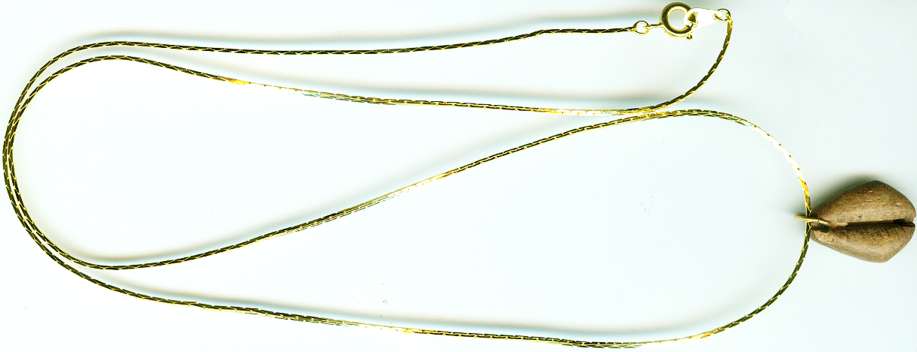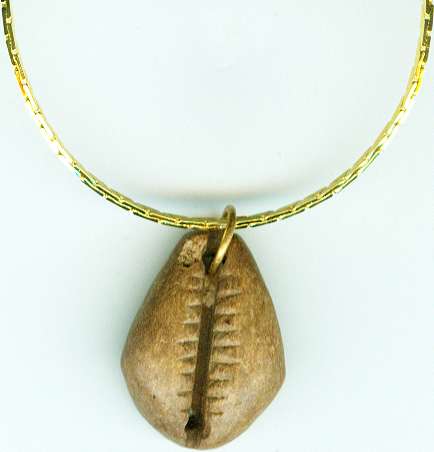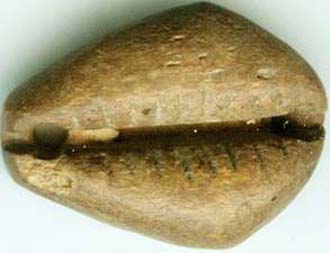













CLASSIFICATION: Hand Carved Wooden Cowrie Shell Money, Hand-Drilled Suspension Hole (Bow Drill). Approximately 800 B.C.
ATTRIBUTION: Ancient China, Western Zhou Dynasty (1027BC-770BC).
SIZE/DIMENSIONS:
Weight: 1.19 grams.
Length: 19 millimeters.
Width: 14 millimeters.
Thickness: 5 millimeters.
Chain: Contemporary gold electroplate 60 centimeters (24 inches). A wide variety of other chains are available upon request in sizes from 16 to 30 inches, and in metals ranging from gold and silver electroplate to sterling silver and solid 14kt gold as well as a bronze-toned copper chain. The default chain (absent contrary instructions) is gold electroplate, 24 inches. For a more authentic touch, we also have available handcrafted Greek black leather cords.
CONDITION: Exceptional! Completely intact.
 DETAIL: A remarkable hand carved wooden cowrie shell money pendant/amulet almost 3,000 years old attributable to the Western Zhou Dynasty of ancient China. Though the use of shells as “money” originated in Sumeria around 3,000 B.C., it was the cowrie shell that became the world’s longest-lived form of currency. The first use of cowries, the shell of a mollusc that was widely available in the shallow waters of the Pacific and Indian Oceans, was in China around 1,200 B.C. Historically, many societies have used cowries as money, and even as recently as the middle of the last (20th) century, cowrie shells were still used in some parts of Africa. As such the cowrie shell was the most widely and longest used currency in history. So important a role did the cowrie play as money in ancient China that its pictograph was adopted in their written language for 'money'.
DETAIL: A remarkable hand carved wooden cowrie shell money pendant/amulet almost 3,000 years old attributable to the Western Zhou Dynasty of ancient China. Though the use of shells as “money” originated in Sumeria around 3,000 B.C., it was the cowrie shell that became the world’s longest-lived form of currency. The first use of cowries, the shell of a mollusc that was widely available in the shallow waters of the Pacific and Indian Oceans, was in China around 1,200 B.C. Historically, many societies have used cowries as money, and even as recently as the middle of the last (20th) century, cowrie shells were still used in some parts of Africa. As such the cowrie shell was the most widely and longest used currency in history. So important a role did the cowrie play as money in ancient China that its pictograph was adopted in their written language for 'money'.
During the Zhou Dynasty four different forms of money developed in ancient China. Aside from the traditional cowrie shells, iron, copper, and wooden forms of money were also traded. Beginning sometime around 900 B.C., iron was crafted into spade and knife shapes, as well as round disks with square holes (the predecessor of the prototypical ancient Chinese coin). Given the importance of the cowrie shell, it should come as no surprise that hand carved wooden imitation cowrie shells such as this one were also produced for use as “money”. By about 600 A.D., copper and bronze cowrie shells were also being used as money. Copper and bronze agricultural implements were also used as money. In fact, before the close of the Zhou Dynasty, squares of white deerskin leather were also being used as money, in all likelihood the ancient world’s first form of a “bank note”.
Regardless of whether you choose to wear it or to display it, this is a truly significant and very beautiful artifact – one of mankind’s first abstract forms of “money”. The shell coins of Sumeria and ancient China are quite significant in cultural and anthropological terms, mankind’s first intangible, abstract form of money. Prior to this time goods of value might be bartered for other goods; but never sold for “money”, an abstraction with no intrinsic value. The most common form of “money” prior to such an abstraction was a cow – hardly transportable and not very beautiful when worn! Both the Sumerians and the ancient Chinese wore their money on cords around their neck – an ostentatious display of their wealth – as did the native Americans with their “wampum”. Even this piece seems likely to have been strung. Here’s your chance to ostentatiously display a piece of your own ancient money!
 HISTORY OF THE ZHOU DYNASTY: Sharing the language and culture of the Shang, the Zhou (Chou) Dynasty through conquest and colonization gradually enveloped much of North China. The Zhou dynasty lasted longer than any other, from 1027 to 221 B.C. The early decentralization of the Zhou Dynasty has oftentimes been compared to Europe’s medieval feudal system. However social organization in the Zhou Dunasty was more predicated upon family and tribal ties than feudal legal bonds. Philosophers of the period enunciated the doctrine of the "mandate of heaven", the notion that the ruler (the "son of heaven") governed by divine right. In reality the emperor shared power with the local lords. At times the local lords were oftentimes more powerful than the emperor. In the later dynasty, large scale conflicts oftentimes erupted between rival local lords (eventually culminating in the “Warring States” period).
HISTORY OF THE ZHOU DYNASTY: Sharing the language and culture of the Shang, the Zhou (Chou) Dynasty through conquest and colonization gradually enveloped much of North China. The Zhou dynasty lasted longer than any other, from 1027 to 221 B.C. The early decentralization of the Zhou Dynasty has oftentimes been compared to Europe’s medieval feudal system. However social organization in the Zhou Dunasty was more predicated upon family and tribal ties than feudal legal bonds. Philosophers of the period enunciated the doctrine of the "mandate of heaven", the notion that the ruler (the "son of heaven") governed by divine right. In reality the emperor shared power with the local lords. At times the local lords were oftentimes more powerful than the emperor. In the later dynasty, large scale conflicts oftentimes erupted between rival local lords (eventually culminating in the “Warring States” period).
The late Zhou Dynasty’s potpourri of city-states became progressively centralized, characterized by greater central control over local governments and systematic agricultural taxation. The iron-tipped, ox-drawn plow, together with improved irrigation techniques, brought higher agricultural yields, which, in turn, supported a steady rise in population. The growth in population was accompanied by the production of much new wealth, and a new class of merchants and traders arose. However in 771 B.C. the Zhou court was sacked, and its king was killed by invading barbarians who were allied with rebel lords. The Zhou retreated eastward relocating their capital city. Today historians divide the Zhou Dynasty into the Western Zhou (1027-771 B.C.) and Eastern Zhou (770-221 B.C.). The west was abandoned, and the power of the Eastern Zhou Dynasty gradually diminished. The Eastern Dynasty itself is further divided by historians into two periods reflecting the accelerating fragmentation and disintegration of China. The first from 770 to 476 B.C. is called the Spring and Autumn Period. The second is known as the Warring States Period (475-221 B.C.), as China completely dissolved.
Though marked by disunity and civil strife, these two periods marked an era of cultural advancements known today as the "golden age" of China. Commerce was stimulated by the introduction of coinage. The use of iron not only revolutionized the production of weaponry but also the manufacture of farm implements. An atmosphere of reform was the result of the competition between rival warlords to build strong and loyal armies, requiring increased economic production and a strong tax base. This created a demand for ever-increasing numbers of skilled, literate officials and teachers (a “civil service”), recruited on merit. Public works such as flood control, irrigation projects, and canal digging were executed on a grand scale. Enormous walls were built around cities and along the broad stretches of the northern frontier. Many of the era’s intellectuals were employed as advisers by China’s rulers on the methods of government, war, and diplomacy. So many different philosophies developed during these two periods that the era is often referred to as “The Hundred Schools of Thought”. The period produced many of the great classical writings on which Chinese practices were to be based for the next two and one-half millennia, including those of Confucius (551-479 B.C.).

HISTORY OF CHINESE CIVILIZATION: Remains of Homo erectus, found near Beijing, have been dated back 460,000 years. Recent archaeological studies in the Yangtse River area have provided evidence of ancient cultures (and rice cultivation) flourishing more than 11,500 years ago, contrary to the conventional belief that the Yellow River area was the cradle of the Chinese civilization. The Neolithic period flourished with a multiplicity of cultures in different regions dating back to around 5000 B.C. There is strong evidence of two so-called pottery cultures, the Yang-shao culture (3950-1700 B.C.) and the Lung-shan culture (2000-1850 B.C). Written records go back more than 3,500 years, and the written history is (as is the case with Ancient Egypt) divided into dynasties, families of kings or emperors. The voluminous records kept by the ancient Chinese provide us with knowledge into their strong sense of their real and mythological origins – as well as of their neighbors.
By about 2500 B.C. the Chinese knew how to cultivate and weave silk and were trading the luxurious fabric with other nations by about 1000 B.C. The production and value of silk tell much about the advanced state of early Chinese civilization. Cultivation of silkworms required mulberry tree orchards, temperature controls and periodic feedings around the clock. More than 2,000 silkworms were required to produce one pound of silk. The Chinese also mastered spinning, dyeing and weaving silk threads into fabric. Bodies were buried with food containers and other possessions, presumably to assist the smooth passage of the dead to the next world. The relative success of ancient China can be attributed to the superiority of their ideographic written language, their technology, and their political institutions; the refinement of their artistic and intellectual creativity; and the sheer weight of their numbers.
A recurrent historical theme has been the unceasing struggle of the sedentary Chinese against the threats posed by non-Chinese peoples on the margins of their territory in the north, northeast, and northwest. China saw itself surrounded on all sides by so-called barbarian peoples whose cultures were demonstrably inferior by Chinese standards. This China-centered ("sinocentric") view of the world was still undisturbed in the nineteenth century, at the time of the first serious confrontation with the West. Of course the ancient Chinese showed a remarkable ability to absorb the people of surrounding areas into their own civilization. The process of assimilation continued over the centuries through conquest and colonization until what is now known as China Proper was brought under unified rule.

SHIPPING & RETURNS/REFUNDS: Your purchase will ordinarily be shipped within 48 hours of payment. We package as well as anyone in the business, with lots of protective padding and containers. All of our shipments are fully insured against loss, and our shipping rates include the cost of this coverage (through stamps.com, Shipsaver.com, the USPS, UPS, or Fed-Ex). International tracking is provided free by the USPS for certain countries, other countries are at additional cost. ADDITIONAL PURCHASES do receive a VERY LARGE discount, typically about $5 per item so as to reward you for the economies of combined shipping/insurance costs.
We do offer U.S. Postal Service Priority Mail, Registered Mail, and Express Mail for both international and domestic shipments, as well United Parcel Service (UPS) and Federal Express (Fed-Ex). Please ask for a rate quotation. We will accept whatever payment method you are most comfortable with. Please note for international purchasers we will do everything we can to minimize your liability for VAT and/or duties. But we cannot assume any responsibility or liability for whatever taxes or duties may be levied on your purchase by the country of your residence. If you don’t like the tax and duty schemes your government imposes, please complain to them. We have no ability to influence or moderate your country’s tax/duty schemes.
If upon receipt of the item you are disappointed for any reason whatever, I offer a no questions asked 30-day return policy. Send it back, I will give you a complete refund of the purchase price; 1) less our original shipping/insurance costs, 2) less non-refundable eBay payment processing fees. Please note that eBay does NOT refund payment processing fees. Even if you “accidentally” purchase something and then cancel the purchase before it is shipped, eBay will not refund their processing fees. So all refunds for any reason, without exception, do not include eBay payment processing fees (typically between 5% and 15%) and shipping/insurance costs (if any). If you’re unhappy with eBay’s “no fee refund” policy, and we are EXTREMELY unhappy, please voice your displeasure by contacting eBay. We have no ability to influence, modify or waive eBay policies.
ABOUT US: Prior to our retirement we used to travel to Europe and Central Asia several times a year. Most of the items we offer came from acquisitions we made in Eastern Europe, India, and from the Levant (Eastern Mediterranean/Near East) during these years from various institutions and dealers. Much of what we generate on Etsy, Amazon and Ebay goes to support The Hermitage Museum in St. Petersburg, as well as some other worthy institutions in Europe and Asia connected with Anthropology and Archaeology. Though we have a collection of ancient coins numbering in the tens of thousands, our primary interests are ancient jewelry and gemstones. Prior to our retirement we traveled to Russia every year seeking antique gemstones and jewelry from one of the globe’s most prolific gemstone producing and cutting centers, the area between Chelyabinsk and Yekaterinburg, Russia. From all corners of Siberia, as well as from India, Ceylon, Burma and Siam, gemstones have for centuries gone to Yekaterinburg where they have been cut and incorporated into the fabulous jewelry for which the Czars and the royal families of Europe were famous for.
My wife grew up and received a university education in the Southern Urals of Russia, just a few hours away from the mountains of Siberia, where alexandrite, diamond, emerald, sapphire, chrysoberyl, topaz, demantoid garnet, and many other rare and precious gemstones are produced. Though perhaps difficult to find in the USA, antique gemstones are commonly unmounted from old, broken settings – the gold reused – the gemstones recut and reset. Before these gorgeous antique gemstones are recut, we try to acquire the best of them in their original, antique, hand-finished state – most of them centuries old. We believe that the work created by these long-gone master artisans is worth protecting and preserving rather than destroying this heritage of antique gemstones by recutting the original work out of existence. That by preserving their work, in a sense, we are preserving their lives and the legacy they left for modern times. Far better to appreciate their craft than to destroy it with modern cutting.
Not everyone agrees – fully 95% or more of the antique gemstones which come into these marketplaces are recut, and the heritage of the past lost. But if you agree with us that the past is worth protecting, and that past lives and the produce of those lives still matters today, consider buying an antique, hand cut, natural gemstone rather than one of the mass-produced machine cut (often synthetic or “lab produced”) gemstones which dominate the market today. We can set most any antique gemstone you purchase from us in your choice of styles and metals ranging from rings to pendants to earrings and bracelets; in sterling silver, 14kt solid gold, and 14kt gold fill. When you purchase from us, you can count on quick shipping and careful, secure packaging. We would be happy to provide you with a certificate/guarantee of authenticity for any item you purchase from us. There is a $3 fee for mailing under separate cover. I will always respond to every inquiry whether via email or eBay message, so please feel free to write.

